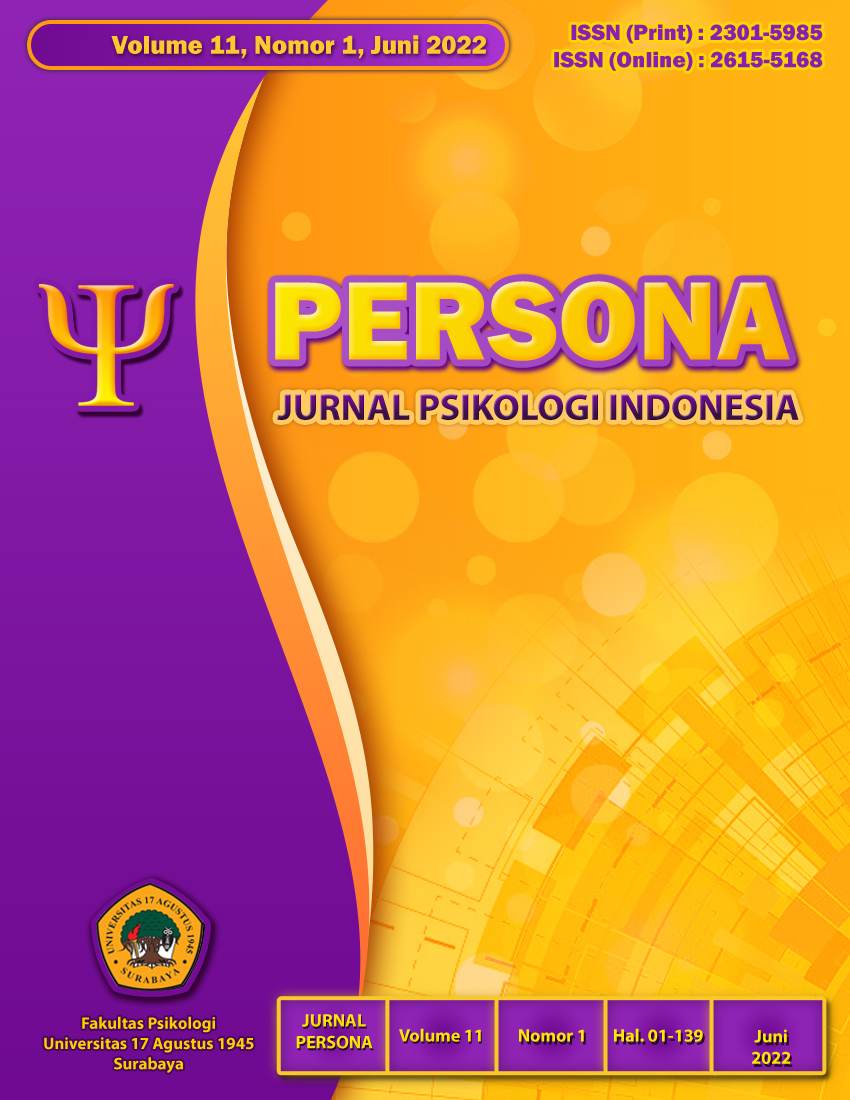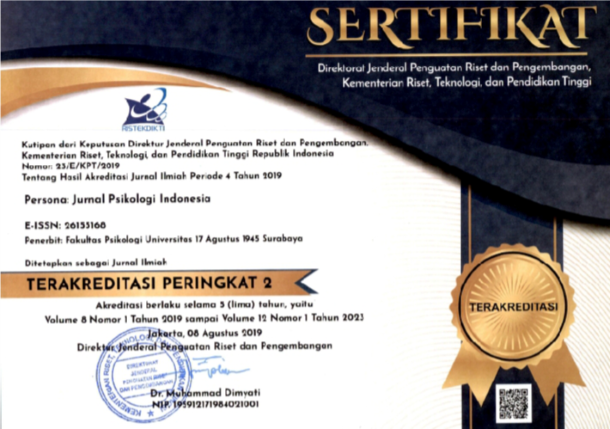Analisis mediasi moderasi pada interaksi persepsi beban kerja rendah dan kebosanan kerja
Abstract
Abstract
Millennial employees experience twice as much boredom at work as the previous generation. They often feel bored because lack of challenges and meaning in work and perceive their work as underloading. This study aimed to examine the mediating role of positive meaning in work in the relationship between the perception of underload work and boredom at work and to see whether that mediation relationship depends on increasing challenging job demands. The instruments used are boredom at work scale (∝ = 0.714), perception of underload work (∝ = 0.75), positive meaning in work (∝ = 0.87), and increasing challenging job demands (∝ = 0.83). The sampling technique used was purposive sampling with the characteristic employee born from 1982 to 1999 who had already worked at their current job for a minimum of six months. Data analysis used PROCESS HAYES model 4 for the mediation model and model 14 for the moderation mediation model. Data obtained from 327 participants showed that positive meaning in work mediated the relationship between the perception of underload work and boredom at work, and increasing challenging job demands had also been found as a moderating role in the relationship between positive meaning in work and boredom at work.
Keywords: boredom at work; increasing challenging job demands; perception of underload work; positive meaning in work; millennials.
Abstrak
Karyawan milenial mengalami kebosanan kerja dua kali lebih sering dibandingkan generasi-generasi sebelumnya. Karyawan milenial sering merasa bosan karena kurangnya tantangan dan makna di dalam pekerjaannya, serta mempersepsikan pekerjaan mereka memiliki beban kerja yang rendah. Penelitian ini bertujuan untuk melihat peran mediasi positive meaning in work dalam hubungan antara persepsi beban kerja rendah dan kebosanan kerja, serta untuk melihat hubungan mediasi tersebut apakah tergantung dari increasing challenging job demands. Instrumen yang digunakan adalah skala kebosanan kerja (∝ = 0.714), persepsi beban kerja rendah (∝ = 0.75), positive meaning in work (∝ = 0.87), dan increasing challenging job demands (∝ = 0.83). Teknik sampling yang digunakan adalah purposive sampling dengan kriteria karyawan yang lahir pada tahun 1982-1999 dan telah bekerja minimal 6 bulan pada pekerjaan saat ini. Analisis data menggunakan PROCESS HAYES model 4 untuk model mediasi dan model 14 untuk model mediasi moderasi. Data dari 327 partisipan menunjukkan bahwa positive meaning in work memediasi hubungan antara persepsi beban kerja rendah dan kebosanan kerja dan increasing challenging job demands juga ditemukan memiliki peran moderasi dalam hubungan positive meaning in work dan kebosanan kerja.
Kata Kunci: kebosanan di tempat kerja; increasing challenging job demands; persepsi beban kerja rendah; positive meaning in work; millennial.
Downloads
References
Agarwal, P., Swami, S., & Malhotra, S. K. (2022). Artificial intelligence adoption in the post COVID-19 new-normal and role of smart technologies in transforming business: A review. Journal of Science and Technology Policy Management. https://doi.org/10.1108/JSTPM-08-2021-0122
Azizah, S. N., & Setyawati, H. A. (2019). Cyberloafing sebagai strategi mengatasi kebosanan kerja. Fokus Bisnis : Media Pengkajian Manajemen Dan Akuntansi, 18(1), 1–7. https://doi.org/10.32639/fokusbisnis.v18i1.301
Clemons, J. (2020). Investigating work engagement and affective commitment through a multi-dimensional work underload scale, mediated by work-related boredom [Master Thesis, California State University]. CSUSB Library Repository. https://scholarworks.lib.csusb.edu/etd/1028
Clifton, J. (2016). How Millennials Want to Work and Live. Gallup Inc. https://www.gallup.com/workplace/238073/millennials-work-live.aspx
Cummings, M. L., Gao, F., & Thornburg, K. M. (2016). Boredom in the Workplace. Human Factors: The Journal of the Human Factors and Ergonomics Society, 58(2), 279–300. https://doi.org/10.1177/0018720815609503
Forastero, A., Sjabadhyni, B., & Mustika, M. D. (2018). What millennials want: How to optimize their work. Psikohumaniora: Jurnal Penelitian Psikologi, 3(1), 1. https://doi.org/10.21580/pjpp.v3i1.2489
Harju, L., Hakanen, J. J., & Schaufeli, W. B. (2014). Job boredom and its correlates in 87 finnish organizations. Journal of Occupational and Environmental Medicine, 56(9), 911–918. https://doi.org/10.1097/JOM.0000000000000248
Harju, L. K., & Hakanen, J. J. (2016). An employee who was not there: a study of job boredom in white-collar work. Personnel Review, 45(2), 374–391. https://doi.org/10.1108/PR-05-2015-0125
Hayes, A. F. (2013). Introduction to Mediation, Moderation, and Conditional Process Analysis : A Regression-Based Approach. Guilford Press.
Hoeng, C. L. L., Aditya, S., Bergita, E., Oeripto, V. G. S. ., Ichsan, A. M., Hesketh, W., Mayang, F. D., Radhitia, M. B., & Effency, O. D. (2019). Generasi milenial dalam industri 4.0 : Bagi sumber daya manusia Indonesia atau ancaman?. Deloitte Indonesia Organization. https://www2.deloitte.com/content/dam/Deloitte/id/Documents/about-deloitte/id-about-dip-edition-1-full-id-sep2019.pdf
Kim, M., & Beehr, T. A. (2020). Thriving on demand: Challenging work results in employee flourishing through appraisals and resources. International Journal of Stress Management, 27(2), 111–125. https://doi.org/10.1037/str0000135
Knight, C., Tims, M., Gawke, J., & Parker, S. K. (2021). When do job crafting interventions work? The moderating roles of workload, intervention intensity, and participation. Journal of Vocational Behavior, 124. https://doi.org/10.1016/j.jvb.2020.103522
Mael, F., & Jex, S. (2015). Workplace Boredom: An Integrative Model of Traditional and Contemporary Approaches. Group and Organization Management, 40(2), 131–159. https://doi.org/10.1177/1059601115575148
Maulina, R. (2018). Pengaruh pelatihan job crafting untuk menurunkan tingkat kebosanan kerja karyawan di perusahaan X Yogyakarta. [Master Thesis, Universitas Islam Indonesia]. UII Library repository. https://dspace.uii.ac.id/handle/123456789/9550.
Naude, M. N. (2015). The development of a measure of work-related underload [Master Thesis, Colorado State University]. Colorado State University Library Repository. http://hdl.handle.net/10217/170404.
Oprea, B., Iliescu, D., Burtaverde, V., & Dumitrache, M. (2019). Personality and boredom at work : the mediating role of job crafting. Career Development International Emerald Publiishing, 24(4), 315–330. https://doi.org/10.1108/CDI-08-2018-0212
Ratu, C. N. (2020). Pengaruh pelatihan “become a great employee with meaningfulness” terhadap keterikatan kerja karyawan. Syntax Idea, 2(8), 363–380. https://jurnal.syntax-idea.co.id/index.php/syntax-idea/issue/view/18.
Reijseger, G., Schaufeli, W. B., Peeters, M. C. W., Taris, T. W., van Beek, I., & Ouweneel, E. (2013). Watching the paint dry at work: psychometric examination of the Dutch Boredom Scale. Anxiety, Stress & Coping, 26(5), 508–525. https://doi.org/10.1080/10615806.2012.720676
Sanchez-Cardona, I., Vera, M., Lugo, M. M., Montalban, R. R., & Centeno, J. M. (2019). When the job does not fit : The moderating role of job crafting and meaningful work in the relation between employees ’ perceived overqualification and job boredom. Journal of Career Assessment, XX(X), 1–20. https://doi.org/10.1177/1069072719857174
Schaufeli, W. B., & Salanova, M. (2014). Burnout , boredom and engagement in the workplace. In M. C. W. Peeters, J. de Jonge, & T. W. Taris (Eds.), An introduction to contemporary work psychology 1st edition (1st ed., pp. 293–320). John Wiley & Sons, Ltd.
Seckin, S. N. (2018). Boredom at work : A research on public employees. Journal of Business Research Turk, 10(1), 639–651. https://doi.org/10.20491/isarder.2018.411
Steger, M. F., Dik, B. J., & Duffy, R. D. (2012). Measuring meaningful work : The work and meaning inventory ( WAMI ). Journal of Career Assessment, 20(3), 322–337. https://doi.org/10.1177/1069072711436160
Sugiyono. (2008). Metode penelitian kuantitatif, kualitatif, dan R&D. ALFABETA.
Susihono, W. (2014, December 4). Assessment kebosanan kerja karyawan sebagai dasar evaluasi kinerja aspek task, organisasi dan lingkungan perusahaan : Studi kasus di kawasan industri Tangerang-Banten [Paper Presentation]. Simposium Nasional RAPI XIII, Surakarta. http://hdl.handle.net/11617/5513
Sutrisno, M. B., & Parahyanti, E. (2018). The impact of psychological capital and work meaningfulness on work engagement in generation Y. Advances in Social Science, Education and Humanities Research, 139, 53–58. https://doi.org/https://doi.org/10.2991/uipsur-17.2018.9
Teng, M., Hassan, Z., Kasa, M., Nor, N. N., Bandar, N. F. A., & Ahmad, R. (2020). Mediating role of boredom in the workplace on turnover intention : A proposed framework. International Journal of Academic Research in Business & Social Sciences, 10(12), 924–938. https://doi.org/10.6007/IJARBSS/v10-i12/8385
Tims, M., Bakker, A. B., & Derks, D. (2012). Development and validation of the job crafting scale. Journal of Vocational Behavior, 80(1), 173–186. https://doi.org/10.1016/j.jvb.2011.05.009
Udemy for Business. (2016). Udemy Workplace Boredom Study. https://research.udemy.com/wp-content/uploads/2016/10/2016-Udemy-Workplace-Boredom-Study.pdf
Umaya, F., Maulina, R., & Budiharto, S. (2020). Job Crafting dan Kebosanan Kerja Karyawan. Gadjah Mada Journal of Professional Psychology, 6(2), 165–176. https://doi.org/10.22146/gamajpp.57576
van Hooff, M. L. M., & van Hooft, E. A. J. (2014). Boredom at work: Proximal and distal consequences of affective work-related boredom. Journal of Occupational Health Psychology, 19(3), 348–359. https://doi.org/10.1037/a0036821
van Tilburg, W. A. P., & Igou, E. R. (2012). On boredom : Lack of challenge and meaning as distinct boredom experiences. Motivation and Emotion, 36, 181–194. https://doi.org/10.1007/s11031-011-9234-9
van Wyk, S. M., de Beer, L. T., Pienaar, J., & Schaufeli, W. B. (2016). The psychometric properties of a workplace boredom scale (DUBS) within the South African context. SA Journal of Industrial Psychology, 42(1), 1–10. https://doi.org/10.4102/sajip.v42i1.1326
Zemke, R., Raines, C., & Filipczak, B. (2013). Generation at work : Managing the Clash of Boomers, Gen Xers, and Gen Yers in the Workplace (2nd ed.). Amacom.
Copyright (c) 2022 Endang Parahyanti, Don Ozzy Rihhandini, Afiyah Tsarwat Zharifah

This work is licensed under a Creative Commons Attribution-ShareAlike 4.0 International License.
The author who will publish the manuscript at Persona: Jurnal Psikologi Indonesia, agree to the following terms:
1. Authors retain copyright and grant the journal right of first publication with the work simultaneously licensed under a Creative Commons Attribution ShareAlike License that allows others to share the work with an acknowledgment of the work's authorship and initial publication in this journal.
2. Authors are able to enter into separate, additional contractual arrangements for the non-exclusive distribution of the journal's published version of the work (e.g., post it to an institutional repository or publish it in a book), with an acknowledgment of its initial publication in this journal.
3. Authors are permitted and encouraged to post their work online (e.g., in institutional repositories, pre-prints sites or on their website) prior to and during the submission process, as it can lead to productive exchanges, as well as earlier and greater dissemination of published work








